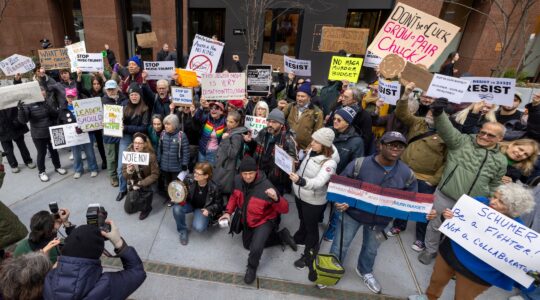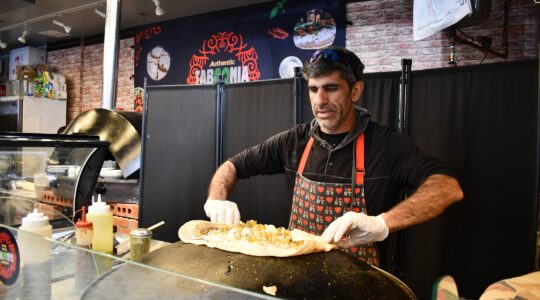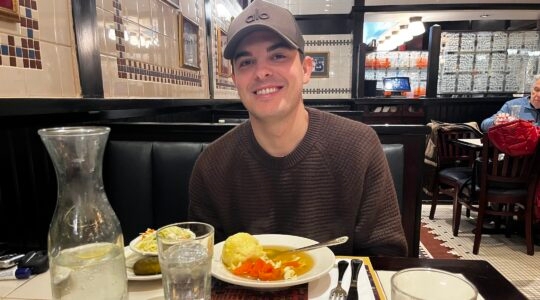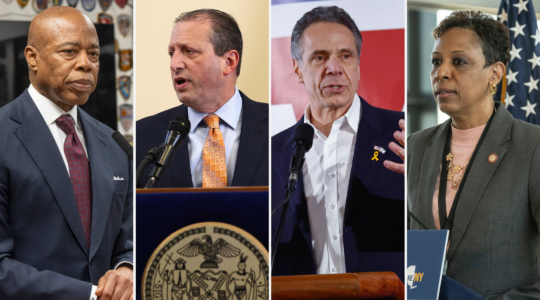Editor’s note: Last weekend the congregants of Lincoln Square Synagogue on 69th Street and Amsterdam Avenue made the move from their old building to their new one, a few doors down the block.
A former president of the congregation reflects on the transition.
As I bid farewell to the building that has been the focus of my spiritual life for the past 42 years, I am swamped with emotion. On Saturday, I attended the final Shabbat morning service at Lincoln Square Synagogue (LSS).
The shul was full; the mood was upbeat; the singing, especially the Hallel prayer recited in honor of Rosh Chodesh, the new moon, was both soulful and joyous. I have known this day was coming for many years, but the reality that the iconic structure in which I, and thousands of others, have spent some of the most profound, challenging and sweetest moments of our lives, will soon face the wrecking ball has focused my attention on what Lincoln Square has meant to me, and to the Jewish people.
Do I stake too bold a claim in mentioning “the Jewish people?” I think not. What Rabbi Shlomo Riskin and the LSS founders created in the early 1960s was nothing less than American Judaism’s model synagogue. Rabbi Riskin fashioned one imaginative program after another, and together they became the standard by which any aspirational congregation, of any denomination, must measure itself: Does it reach out to the community beyond its four walls? Does it concern itself with social and political action? Does it provide adult education? Is everyone made to feel welcome? Is the State of Israel a palpable concern of its congregants? None of those things could be taken for granted in the typical synagogue of 1965.
And what of its neighborhood? Before Lincoln Square, there was not a single Shomer Shabbat, kosher-certified restaurant on the Upper West Side; before LSS there were no beginners’ services at any of its shuls; there were no organized chesed programs; there were no Chabads, no Drisha Institute, no Kehillat Hadar, or the BJ (B’nai Jeshurun) we know today. LSS and its programs were the spark that illuminated the entire West Side and made it the pre-eminently vital Jewish community in America, and a model of what a Jewish community can be — must be — if it is to remain relevant, and thrive.
And what of today? Our new building was born of the purest of motives. I yield to no one in my love and admiration for Lincoln Square’s original structure, but I have no idea how the City of New York and its Fire Department permitted it to be built and occupied. From the moment of its first use it was clear that the lobby space was far too small and its entrance and egress routes were dangerously inadequate. The sanctuary itself, despite the egalitarian beauty of its circular shape and banked pews, was forbidding for those disabled by illness or old age. Religious institutions were grandfathered into exemptions from compliance with the Americans With Disabilities Act of 1990, but was that any excuse to exclude increasing numbers of congregants who could not use the bathrooms, or have access to seats? In addition, we had never taken full advantage of our adjacent building, a former bank, by properly upgrading and connecting it.
Our new home, at 180 Amsterdam Ave., promised, and has delivered, solutions to all these problems. Every inch of religious space is open to all members of our community. The handsome structure that won LSS’s architectural competition is meant to welcome people with mobility issues in a way rarely seen in synagogue construction, in a secure building that is modern, flooded with light, and environmentally sound.
Gary Rosenblatt’s column recently outlined the challenges facing our storied congregation as it enters this new phase of its life (“Lincoln Square’s Gamble,” Jan. 4). A noted sociologist was quoted as saying, “I hope they understand the market.” I think I am speaking for most of my fellow congregants when I describe what we find in the “market” not as challenges, but as opportunities. LSS has the sobering privilege to enter a spectacular new building, in a growing and dynamic neighborhood filled with tens of thousands of Jews, and led by a brilliant, dynamic and sensitive clergy. Our senior rabbi, Shaul Robinson, stated in a recent sermon: “…we should be able to look at ourselves and each other and see not what is, but what can be. Not to imagine, but to create.” LSS has come through its building project unencumbered by debt, and will have the benefit of new revenue streams to help fund the classes and programs that will continue the legacy that has been bequeathed to it.
Over the past 45 years I have been privileged to meet hundreds of people who have been affected by LSS, and there are thousands more, here and in Israel, where so many of them have settled. We, the members of LSS were the recipients of a miracle: an anonymous gift of more than $20 million that enabled us to complete and equip our new building. We believe that the heritage of our past, the vibrancy of our present and the promise of the future combined to earn us this astonishing vote of confidence. At Sunday’s dedication ceremony for the new building, Rabbi Robinson quoted the prophet Hagai, who, upon seeing the Second Temple in Jerusalem, predicted that it would be greater than the first. Our community is united in the resolve to respond to our miracle, in our second temple, and, as we placed our Torahs in their berths in 180 Amsterdam Ave. for the first time, the overflowing congregation of over 500 people sang, as one, Chadesh yameinu k’kedem, “renew our days as of old”; let us continue to share the majesty and beauty of our eternal faith with the thousands of our Jewish neighbors who await our welcoming words and deeds.
Morton Landowne is the executive director of Nextbook, Inc., publishers of the Jewish Encounters book series, and Tablet Magazine. He has been a member of Lincoln Square Synagogue since 1970, and served as its president from 1986-’89.
The New York Jewish Week brings you the stories behind the headlines, keeping you connected to Jewish life in New York. Help sustain the reporting you trust by donating today.




